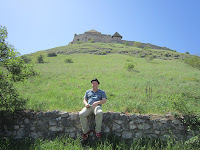 On Thursday this week, the grade 3s and 4s had a Skype conversation with a school in France. The kids learnt four or five different questions and answers. They then stood shyly in front of the camera and mumbled to a French person who mumbled back a response. It was interesting this time to see how the French kids had gotten significantly better than last time we chatted. I think they were more relaxed and just a little bit closer to a natural conversation.
On Thursday this week, the grade 3s and 4s had a Skype conversation with a school in France. The kids learnt four or five different questions and answers. They then stood shyly in front of the camera and mumbled to a French person who mumbled back a response. It was interesting this time to see how the French kids had gotten significantly better than last time we chatted. I think they were more relaxed and just a little bit closer to a natural conversation.
On Friday, I took the day off work to go with Zoli, my citera teacher, and his music group from Nagykálló as they went to the intermediate folk music competition in Sümeg. There was only one more space in the van, so Amanda stayed behind with Iago in Máriapócs. I hear that she had some awesome adventures with Laima
Although the bus trip was long, I spent the time talking to Zoli, his wife and doing my best to communicate to the others with hand signals. They are all students of Zoli's from his Nagykálló school, so the youngest is only thirteen years old and the oldest is eighteen years old. All in all, it was a pretty easy trip. The only thing was that it was very hot. Winter is well and truly over with temperatures hitting the low thirties so being stuck in a van with eight other people was kind of unpleasant.
 It was a great relief to get to Tihany, a small town on Lake Balaton, where we stopped for a while, let our feet soak in the water and had a beer. It was a fantastic way to cool down after the long hot drive. Before long we were back on the road however to our destination in Sümeg.
It was a great relief to get to Tihany, a small town on Lake Balaton, where we stopped for a while, let our feet soak in the water and had a beer. It was a fantastic way to cool down after the long hot drive. Before long we were back on the road however to our destination in Sümeg.
In Sümeg, we were all staying in the second storey of a house, where the owners lived in the bottom storey. There wasn't a lot of room, but we all managed to find a place to lay down our bags and get to the business of cooking dinner, drinking and playing music. It's kind of awesome how much the kids in the band really enjoy folk music, give them half a chance and they'll be taking out their instruments and before long they'll be playing, dancing and singing. It was really a great night.
The next morning, after breakfast and a quick rehearsal, we all headed off to the first performance of the day. The town's music center/concert hall was packed with people awaiting their turn to perform. I'm not too sure when it started, but by the time we got there at 10am it seemed like it had already been going on for hours. The doors were closed for each performance, sometimes it was a single child singing a folk song and at other times it was a fully complemented choir, when they were finished, the doors open to allow people to enter and exit the concert hall and then the next performance came on.
After the Zoli's band had played we went back to the house for lunch then went to check out the Sümegi castle. The kids weren't interested so they stayed at the car while we climbed the hill. The castle was quite awesome, with many walls to climb over and plenty of equipment to play with, but it just wasn't the same without Amanda and Iago. We've had a lot of fun exploring the various European castles and between the three of us we've gotten pretty good at it. Can't complain though, it was a fairly awesome castle.
We were all exhausted by this stage so it was a sleepy five hour drive back to Nagykálló, where Amanda picked me up at around 1am. A great weekend!
- Daniel.


















































